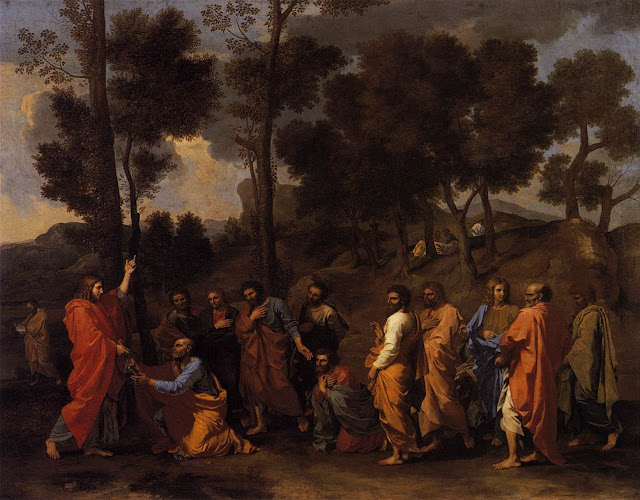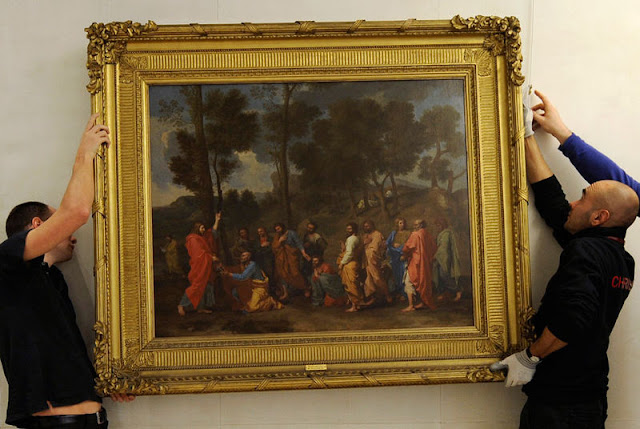
Yesterday while I was aimlessly chatting here about Poussin (in context of reading Michael Fried about Caravaggio) all unbeknownst to me there was a major Poussin canvas going up for auction at Christie's in London. Since there are hardly any Poussins that are not safely shut away in art museums, they almost never come up for sale. The painting in question is Ordination, created in the 1630s for the antiquarian scholar and collector Cassiano dal Pozzo who commissioned seven compositions, each depicting one of the seven Sacraments.

Christie's expected to sell the painting for somewhere between $25 and $30 million. The seven Sacraments have been owned by the Dukes of Rutland since the 1780s. One perished in a fire and one was sold to an American tycoon in the 1930s. The five survivors in the suite have been on view at the National Gallery in London as long-term loans for the past several years. Then this year the Rutland Trustees decided to sell one off to pay for restoration of Belvoir Castle – not a popular decision among the art lovers of England, needless to say.

Yesterday's sale, then, turned out to be bad news for the Trustees and good news for the art lovers when bidding on the painting stalled at $21 million. With the reserve unmet, Ordination went unsold. And to me this seems very peculiar, considering the prices fetched just in the past couple of months for paintings by such comparative 20th-century lightweights as Modigliani ($69 million), Matisse ($49 million), and campy old Alma-Tadema ($36 million). One explanation I've read is that potential buyers were aware the British government might impose an export ban if the sale went through.

I wonder what Poussin would think of all this fuss. In his lifetime his paintings sold steadily, but only for modest prices and he lived austerely in his Roman studio. In fact, in a second Poussin coincidence that occurred today, I was reading Anthony Blunt's book from Harvard University Press about the architect Borromini (last month I talked about Sant'Ivo, one of Borromini's baroque Roman churches here – and the one I was studying today, San Carlino, is below).

There is no evidence that Borromini ever met Poussin, though they were both living and working in Rome throughout the mid-seventeenth century – but Blunt himself chose to pull Poussin into the Borromini story (just as yesterday Fried pulled Poussin into the Caravaggio story). And I have to say that anybody's random reading does seem to turn up these odd conjunctions with startling regularity. Here then is Blunt's rather moving passage comparing Borromini's mental health with Poussin's and accounting for the difference:
"Borromini, though physically of a fine presence, lacked all the social graces. He was melancholy, nervous and uncompromising, and these qualities soon turned to a neurotic fear of all human contacts and a suspicion of people, which almost reached the stage of persecution mania. He quarreled with many of his patrons and on several occasions threw up commissions, sometimes voluntarily, sometimes because he was threatened with dismissal ... Perhaps partly as a result of his early experiences with Bernini, he was so frightened that other architects would steal his ideas that just before his death he destroyed a great part of his unexecuted designs. It can have been no surprise to his few friends when he finally took his own life. But this intensely strained and nervous side of his character was accompanied by a passionate and total devotion to his art. He cared nothing for the things of the world and, according to his early biographers, often refused to take money in order to keep complete freedom in directing the buildings of which he took charge. This obsession with his art is reminiscent of his contemporary, the painter Nicolas Poussin, who likewise gave up all the advantages which he could have gained in the public life of Rome in order to devote himself to his painting; but his problem was easier. He could shut himself up in his studio and refuse to see intruders; Borromini had of necessity to deal with patrons and workmen and to cope with practical problems. Perhaps it was for this reason that Poussin retained his sanity, whereas Borromini's mind became unsettled towards the end of his life."
